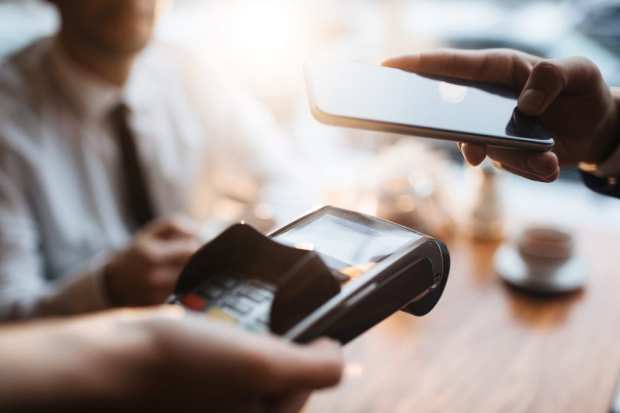Is The US On The Verge Of A Contactless Surge?

Near-field communication (NFC) technology isn’t exactly new. For some time now, retailers have been using it and radio frequency identification (RIFD) behind the scenes for stock and quality control, as well as to provide product information to customers with smartphones. However, the U.S. has been slower to adopt contactless payments than other parts of the world, Europe in particular.
According to payment gateway NMI, just 3 percent of payments in the U.S. don’t rely on swiping or chip card readers. In other words, nearly all U.S. cards use chip-and-signature and chip-and-PIN methods.
The new PYMNTS mPOS Tracker takes a look at the state of mPOS solutions in North America. The global mPOS industry was valued at $26 billion as of 2018, and is projected to grow 35.4 percent between 2018 and 2025.
Will Americans finally be able to “tap and pay” in the near future?
What’s holding back adoption is kind of a chicken-and-egg situation. Card issuers have been slow to release contactless cards due to limited acceptance at the point of sale. But not all merchants want to invest in new payment terminals without mainstream adoption of contactless payments.
When contactless payments started gaining traction in the mid-2000s, there were rampant fears about security. JPMorgan Chase launched a contactless card called Blink back in 2005, then killed it off in 2014 ahead of the push for EMV chip cards.
But EMV chip cards are more secure than magnetic stripe transactions, and newer versions of contactless cards use EMV. JPMorgan Chase will roll out new Visa-branded contactless EMV cards this year.
While credit cards are playing catch up, consumers have been using smartphones enabled with Apple Pay, Google Pay and other offerings for contactless payments. In the U.S., the payments landscape is often dictated by market forces, whereas in other countries, card brands operate according to mandates from member banks or the government.
Last year, Visa’s Chief Executive Alfred F. Kelly revealed that 70 of the company’s top merchants now accept contactless cards, up by more than 20 in a year.
“On the issuing side, several of our largest clients will begin issuing contactless cards over the next few quarters. We expect there will be over 100 million Visa contactless cards issued in the United States by the end of 2019,” he said.
While retailers are still getting on board, food service brands like Starbucks and Dunkin’ offer contactless payment through their own popular apps.
Even the Metropolitan Transit Authority (MTA) in New York City, not exactly known for its technological advances, recently stepped into the 21st century with tap and pay options. Last month, it announced acceptance of Apple Pay, and just a few days earlier it was reported that the MTA would offer Google Pay at select subway stations and on some buses.
The rise of wearables might also give contactless payments a nudge. The global wearables market is projected to grow 15 percent annually until 2023.
This growth is being driven by smartwatches in particular. Global shipments increased 48 percent year over year in Q1 2019 and accounted for 44 percent of the overall wearables market in 2018, a share that is expected to reach 47 percent by 2023.
Apple has been embarking on partnerships that rely on Apple Pay either via a smartphone or Apple Watch. This implementation doesn’t require a special terminal, just an NFC-enabled label or sticker. One such venture is with scooter rental company Bird. Through NFC, users can tap a phone or watch and automatically pay for rentals. Apple also partnered with clothing retailer Bonobos to offer tap and pay options on display racks.
Some companies like French sporting goods retailer Decathlon are exploring QR codes instead. In Decathlon’s U.S. store that recently opened in California, it has deployed 20 RFID-enabled mobile checkout stations.
NFC might stand a better chance of adoption for contactless payments than QR codes, since it can enable faster transactions. Users don’t have to select an app or open a camera as they do with QR codes. QR codes are also seen as riskier for security, and can be used to link to malware or phishing sites.
In the U.S., boosting mainstream adoption of contactless payments is likely in the hands of card issuers.
In an interview with PYMNTS, Nick Starai, chief strategy officer for payment gateway NMI, said, “As card issuers begin accelerating their issuance of cards with EMV contactless capability, we believe we’re going to see contactless surge.”
